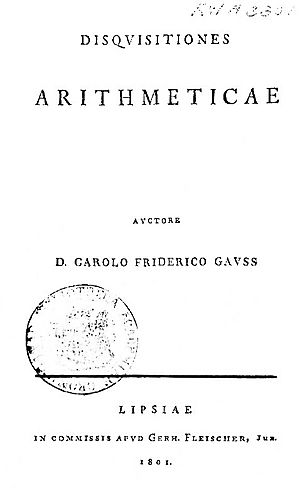Chinese remainder theorem facts for kids
The Chinese remainder theorem is a cool idea from number theory, which is a branch of mathematics that studies numbers. It helps us solve puzzles about remainders when you divide numbers. Imagine you have a secret number, and you know what's left over when you divide it by different small numbers. This theorem helps you find that secret number!
This theorem was first written down in the 3rd century AD by a Chinese mathematician named Sunzi. He put it in his book called Sunzi Suanjing.
Contents
What is the Chinese Remainder Theorem?
The Chinese remainder theorem helps us find a whole number that leaves specific remainders when divided by several other numbers. Think of it like a riddle where you're given clues about leftovers.
For example, an old puzzle asks:
- How many soldiers are there in Han Xin's army?
- If they line up in rows of 3, 2 soldiers are left over.
- If they line up in rows of 5, 3 soldiers are left over.
- If they line up in rows of 7, 2 soldiers are left over.
The theorem tells us that there's often a way to find the total number of soldiers that fits all these conditions!
How Does it Work?
The main idea behind the theorem is about finding a number that "fits" several different rules at once. Each rule is about a remainder after division.
Understanding Remainders (Modular Arithmetic)
When we talk about remainders, we are using something called modular arithmetic. It's like clock arithmetic.
- On a 12-hour clock, 13 o'clock is the same as 1 o'clock. The remainder of 13 divided by 12 is 1.
- So, 13 is "congruent" to 1 (modulo 12).
The Chinese remainder theorem deals with numbers that are congruent to different remainders for different divisors.
Where is it Used?
The Chinese remainder theorem isn't just for old puzzles. It's very useful in modern technology!
Keeping Secrets Safe (Cryptography)
One of the most important uses of this theorem is in cryptography. This is the science of writing and solving codes to keep information secret.
- For example, it's used in the RSA algorithm. The RSA algorithm is a way to encrypt (code) messages so that only the right person can read them. It's used every day when you send emails or shop online to keep your information safe.
Other Uses
The theorem also has uses in other areas of computer science and engineering. It helps with things like:
- Making calculations faster in computers.
- Solving problems in signal processing, which is about how we handle and understand information from sounds or images.
History of the Theorem
The first known mention of this theorem was by the Chinese mathematician Sunzi. He lived in the 3rd century AD, which is a very long time ago! His work showed how to solve systems of congruences.
Later, in the 13th century, another Chinese mathematician named Qin Jiushao published a more general way to solve these problems.
The theorem became well-known in the Western world much later. The famous German mathematician Carl Friedrich Gauss included it in his important book Disquisitiones Arithmeticae in 1801.
See also
 In Spanish: Teorema chino del resto para niños
In Spanish: Teorema chino del resto para niños


